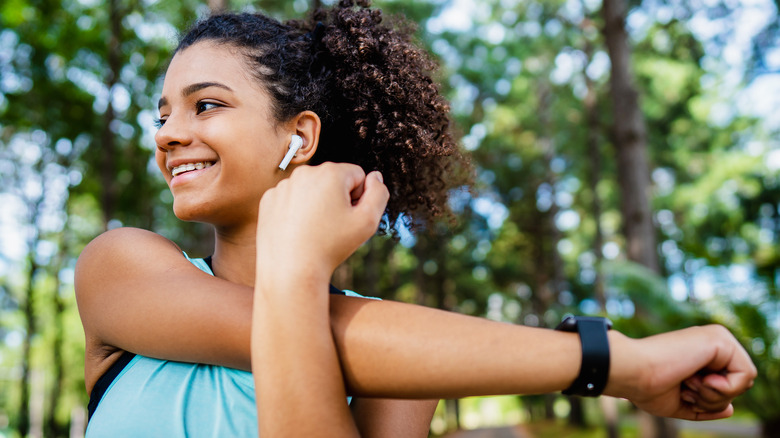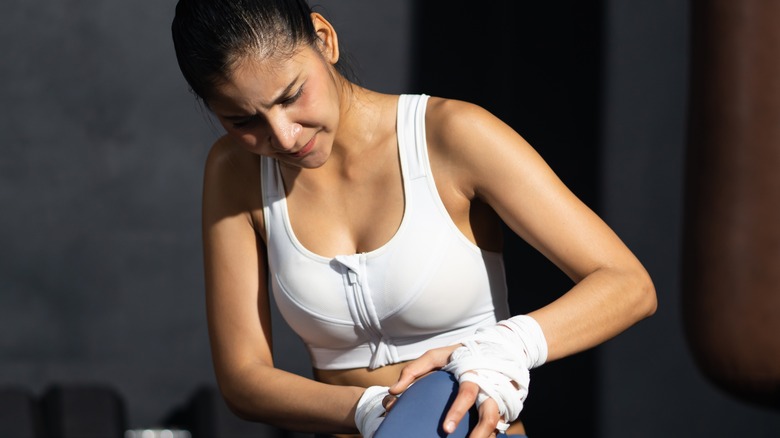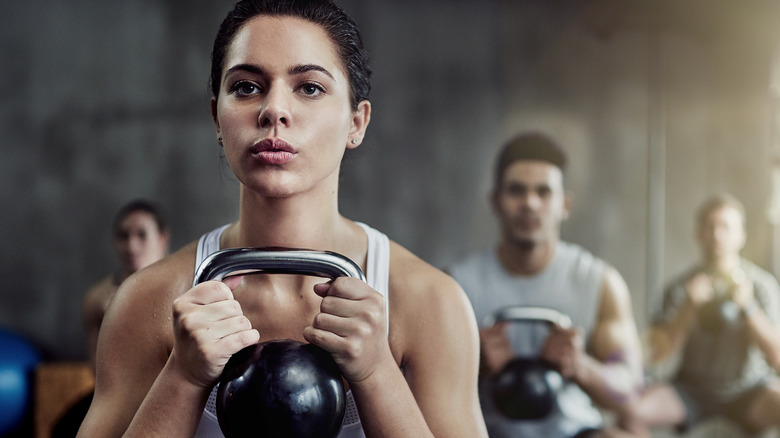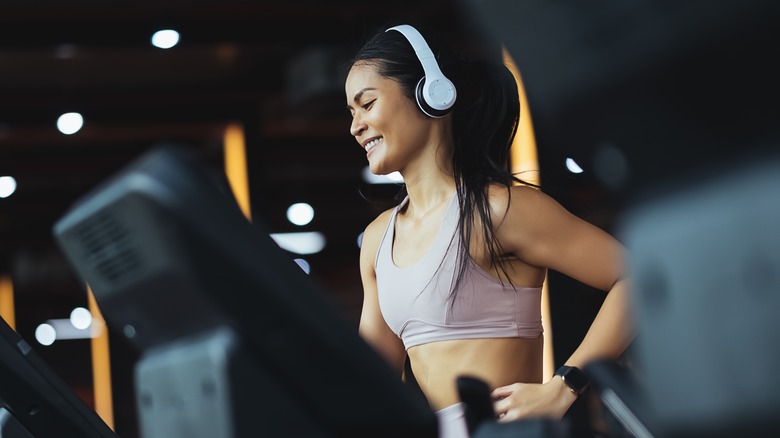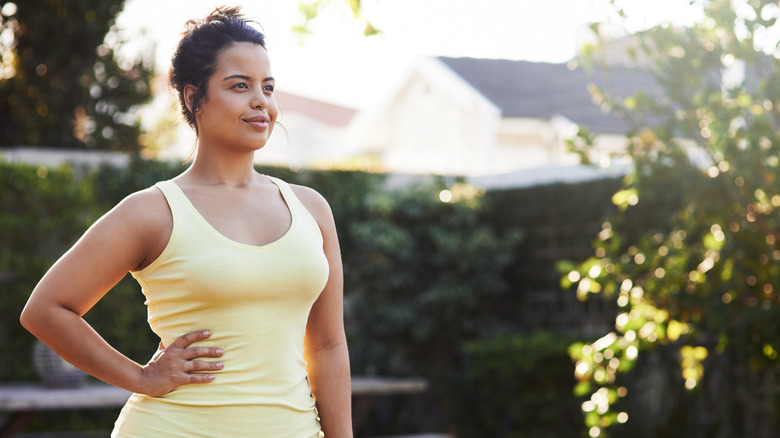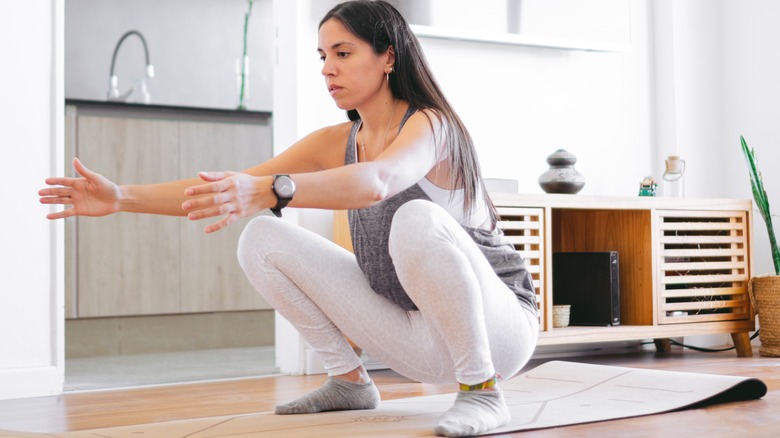Fitness Myths From TikTok You Should Immediately Stop Believing
It's no secret that exercise is great for you, but what's not so great is blindly following any type of fitness advice from TikTok influencers. Of course, there are definitely some people worth following on the online platform if you're interested in learning some valuable, trustworthy, and real advice from fitness enthusiasts. Personal trainers and professional athletes, for example, won't steer you wrong.
But if you're hoping to glean anything more from "FitTok," be aware that it's not all it's cracked up to be. In fact, many of the so-called "facts" shared under the FitTok tag are purely incorrect, according to personal trainer Maiken Brustad. He analyzed some of the content and discovered that many contained either wrong advice or depicted poor exercise form, which could ultimately lead to injury. Per Inside Fitness, he even described one video as "definitely not a video [he] would use."
Sadly, this may mean it's best not to get your kettlebell-swinging technique from the fine folks on FitTok, or learn the best possible way to perform a squat from the platform. Nor should you look to the app for wellness inspiration, as many of the concoctions and tips you've come across are probably not rooted in any type of reality. You're far better off working with a personal trainer or asking for advice from a trusted friend or family member who you know has a background in exercise or fitness. Here are just a few fitness myths on TikTok you shouldn't believe.
No pain, no gain is the only way
Talk about a false claim — and it's one that's been spouted well beyond the realms of TikTok. Extreme exercise and overtraining can take their toll in many ways, affecting everything from your enthusiasm to your ability to work out properly. Taking yourself to the limit could even lead to injuries, which could have long-term effects on your fitness goals. Explains Liz Au, the FITWELL coordinator at UCLA Recreation, "Overtraining can bring about a slew of symptoms, and the key to preventing overtraining is to listen to your body, pay attention to signs of fatigue, persistent soreness or decreased performance" (via UCLA Health).
Simply put, intense discomfort should never be a prerequisite for fitness progress. While it's true that challenging workouts are an integral part of improving your overall physical fitness, they need to be balanced with adequate rest and recovery to avoid pitfalls like overuse injuries. In fact, a 2015 study (via the University of Rhode Island) found that this was the culprit for 30% of sports injuries suffered among American college students.
Working out too hard could even prove more dangerous to your long-term health. Dr. Niloofar Nobakht, MD, an associate clinical professor of nephrology at UCLA, explains that people can develop a condition called rhabdomyolysis, which develops as muscle tissues weaken and release a type of protein that may affect kidney function. "Exertional rhabdomyolysis can occur after strenuous exercise and from high-intensity workouts during which the muscles are overused."
Toning and tightening is a real thing
Toning and tightening sound like very pro-fitness concepts, but these popular TikTok obsessions aren't exactly accurate. While it does sound great in theory, there's no actual workout that can "tone" or "tighten" a specific area because it's not possible to focus solely on areas on your body where you'd like to see a little less fat and a lot more muscle.
It's helpful to understand what "toning" means in the FitTok universe. There's a misconception that you can firm up your body — but muscles can only grow larger or become smaller. There's no special exercise, contrary to what TikTok may have you believe, that can magically change how they feel. A "toned" look itself may best be described as the ability to see said muscles as you lose fat through a healthy diet and exercise plan.
According to Men's Health fitness director Ebenezer Samuel, C.S.C.S., "Muscle toning is a marketing idea. It's nothing you're actually going to learn in any fitness book ever. It's just not a real thing — it's going to prevent you from reaching your goals." This alone should help redirect your energy into creating a workout plan that includes all of the right elements to build muscle and reduce fat, thereby creating the so-called "toned" look.
Treadmill walks need to be done precisely the right way
It's no secret that walking on the treadmill is a great way to get in shape. Nothing beats taking a stroll in the comfort of your own home or at the gym. The downside is that this longtime workout has received the FitTok treatment, and now an entire legion of treadmill users believe that you can walk at a certain incline and at a certain speed to help burn fat and get you fit more efficiently than you would while running.
For example, take the trend that suggests walking on a treadmill at a 12 to 15 incline while at a speed of 3.2 miles per hour is more effective at retaining muscle and burning fat than even going for a run. According to personal trainer Ben Carpenter, this is inaccurate. "This is a myth. There is no secret treadmill formula that works significantly better for fat loss and muscle growth" (via Yahoo! Life).
He adds that it's part of a growing trend on TikTok that finds users adjusting treadmill settings to random figures simply to become part of a viral moment. However, there is something to be said for walking at an incline. It's harder to do than walking on level ground, and it will drive up your heart rate while helping your body shed unwanted pounds and burn fat. Eric Sung, C.S.C.S., explains to Men's Health that to build muscle, though, you'll need to add resistant training to the mix.
You can spot reduce
This is the kind of myth that has circulated for decades, and it's certainly not only TikTok that is to blame for its prevalence. However, social media hasn't helped nip the idea in the bud that you can burn fat from select areas of your body as needed. It would certainly be nice if you could perform a bunch of sit-ups and magically enjoy the rock hard, sleek stomach of your dreams — but it simply doesn't work that way.
Sadly, FitTok has millions across the globe believing precisely the opposite. Refuting the claim is easier when you consider how fat behaves in the body. It's stored for energy, and when the body calls on those stores for a little boost, it breaks down the fat from anywhere, not strictly from the area that you wish looked a little better. The only way to truly see results is to adopt a strength and resistance training program to help you develop muscle and shed fat.
According to personal trainer Kim DiLandro (via CNET), "The only way to reduce fat in any part of your body is to eat in a calorie deficit and focus on full body strength training." Fitness trainer Gwinyai Murahwa says to Philly Mag, "Good influencers will tell you that there are no shortcuts, that you've got to invest time and sweat in yourself to get long-lasting results."
You can whip up fat burners at home
Wouldn't it be great if you could pop into the kitchen and prepare a concoction that would magically help you lose the unwanted fat? TikTok influencers would have you believe that you can — but the simple truth is that there is absolutely no "magic" recipe that will have you looking like a fitness guru yourself simply through your kitchen creations alone.
Of course, FitTok myths abound. From apple cider vinegar to lemon water to coconut water to the latest "oatzempic" fad, everything seems to have found its way to the top of the list at some point or another, only to be dethroned by another ultimately. Many FitTok influencers claim that such concoctions can help you burn fat, lose weight, or kickstart your metabolism, all without doing so much as taking a sip or a bite.
It's true that many of the ingredients are good for you, but nothing can replace the benefits of actual exercise for supporting your body goals and helping you become fitter and stronger. As Dr. Debbie Fetter, an assistant professor in the department of nutrition at the University of California, Davis, states to The Guardian, "[Lemon water] is not going to do any harm. Is it a miracle beverage? Probably not."
Squat hard to see results
Squatting is a highly recommended exercise, says Joel Hardwick, an exercise physiologist who practices at the Piedmont Atlanta Fitness Center. It's a popular addition to modern workouts, so it's no surprise that TikTok abounds with squat trends galore, including the "Madonna squat" and the 1000 squats a day challenge. These call on you to really put your body to the test, using a variety of joints and muscles to really set your quads, calves, hamstrings, and core on fire.
That burn can feel good, but Hardwick stresses that a safe movement that does not involve going too low is best for preventing injury. "Your brain doesn't know how to accomplish that specific movement," Hardwick explains to Piedmont Healthcare. But you should never feel like you're struggling. If you can't perform a specific type of squat that calls for you to get especially low to the ground, that's just a sign that you need to work those muscles that are engaged during this exercise.
Physical therapist Jacob VanDenMeerendonk, DPT, told Well+Good that it's important to spend time "focusing on core strengthening and spinal stability exercises." Focus less on the viral squats that are next to impossible for the average person to do and more on getting strong enough to perform safe squats that you can then incorporate into your exercise routine.
You can dance your way to a smaller belly
If you love to dance, you should continue to dance for your health and your overall wellbeing. But don't focus strictly on TikTok's "weight loss dance," because it just won't yield results that you hope to see. This was popularized when a TikTok user posted a video of herself performing a now-viral dance that purports to burn body fat and help you lose weight fast. While the user claims to be a fitness instructor, there are no credentials or otherwise notable details that impart any confidence in the dance claim.
It's not limited to one user, though. As these TikTok videos go viral, people begin to believe every word. Certified nutrition coach Joanne Schell says to Shape, "Posts like this put value primarily on outward appearance; in truth, a six pack is either genetically created or takes significant diet and exercise changes — often to the point where sleep, social lives, and hormones [can be] disrupted and disordered eating [can] arise."
As the user responsible for the viral dance video claims that the routine will "reduce" the abdomen, it's important to be mindful of what you're watching and falling prey to fad diet trends. Psychologist Sirin Atçeken tells Cosmopolitan, "We are constantly bombarded by adverts selling us unrealistic expectations, 'quick fixes,' and easy way-outs. In a time where we are calling out fake news, it can be quite dumbfounding that certain content even passes advertising standards."
Monthly challenges can kickstart your fitness
Those monthly challenges are absolutely everywhere. You can't escape a browse through TikTok without coming across an influencer encouraging you to join a 30-day challenge for complete body transformation. Maybe it's doing hundreds of squats a day, doing something with the kettlebell, or adding minutes to your run as the month progresses.
While you do want to build stamina by boosting your workouts as you go, you don't want to be too vigorous or you risk burning out or getting injured." According to clinical exercise physiologist Heather Milton of the Sports Performance Center at NYU Langone Health (via The New York Times), "Each person has individual needs based on genetics, medical history, including injury history and body type." This means that engaging in potentially unsafe activities could put you at considerable risk, especially if you aren't entirely sure how to perform the exercise in question in a safe way.
Many of these challenges involve working out consistently for the entire month, which also means you won't get any breaks whatsoever. The best exercise regimens incorporate at least a couple of rest days to ensure that you don't overdo it or hurt a muscle. Either of these situations could set you back days or even months, which could hinder your progress dramatically.

